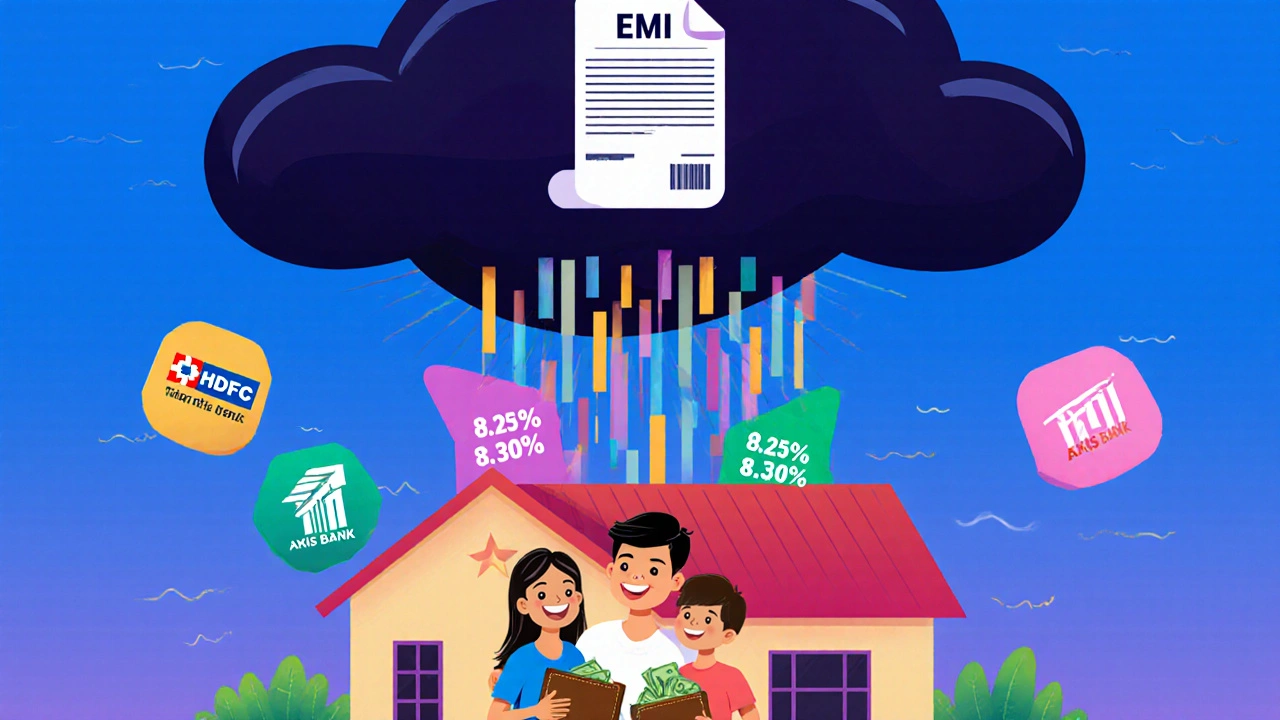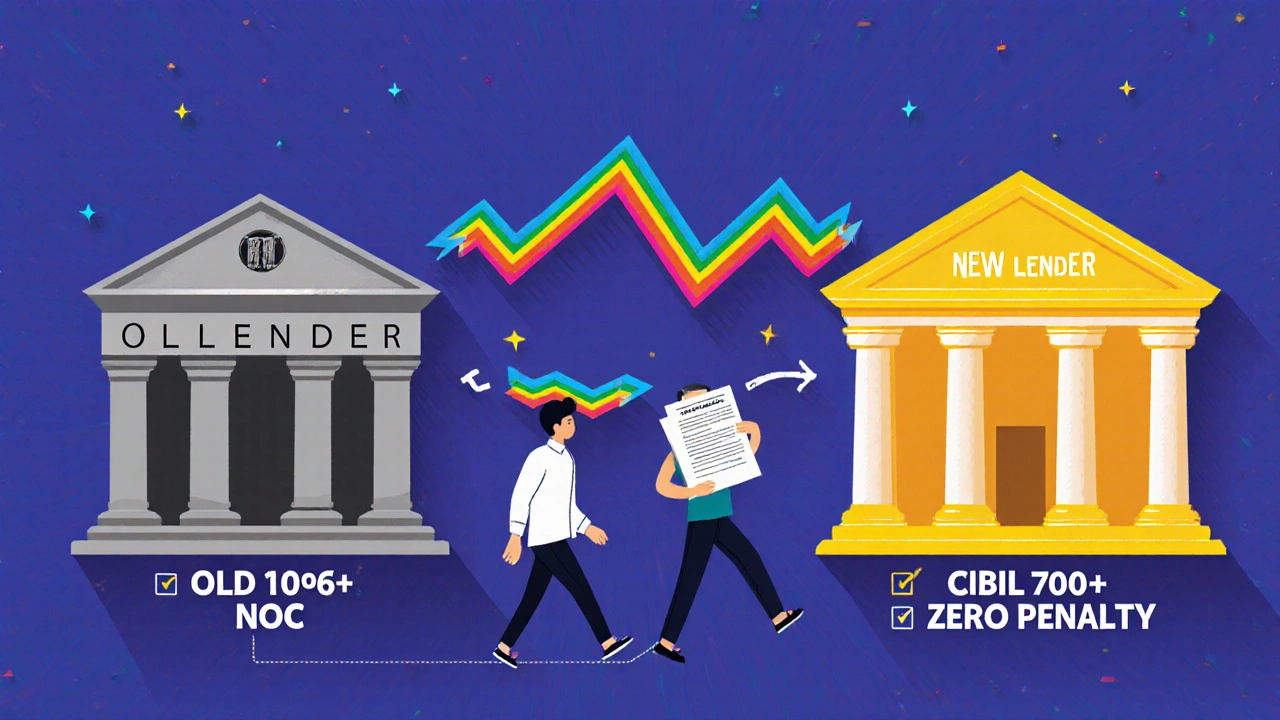How to Use a Home Loan Balance Transfer in India to Reduce EMI
 Nov, 26 2025
Nov, 26 2025
Every month, your home loan EMI eats into your budget like clockwork. You’re paying thousands every month, and it feels like the principal barely budges. What if you could lower that payment-without refinancing your entire life? In India, a home loan balance transfer isn’t just a buzzword-it’s a real way to slash your EMI, save lakhs over time, and take back control of your finances.
Why Your Current Home Loan Might Be Costing You More Than It Should
When you took out your home loan, interest rates were higher. Maybe you got a floating rate tied to an older benchmark, or your lender didn’t offer the best terms. Today, rates have dropped. Banks like HDFC, ICICI, and Axis are offering home loans at 8.5% or even lower. But your existing loan? It’s still at 9.5%, 10%, or worse.
Here’s the math: A ₹50 lakh loan at 10% for 20 years means a monthly EMI of ₹48,251. At 8.5%, that same loan drops to ₹42,066. That’s a saving of ₹6,185 every month. Over 20 years, that’s over ₹14.8 lakh in interest saved. That’s not just a little extra cash-it’s a vacation fund, your child’s education, or a down payment on your next property.
But here’s the catch: You can’t just ask your current bank to lower your rate. Most won’t. That’s where balance transfer comes in.
What Exactly Is a Home Loan Balance Transfer?
A home loan balance transfer means moving your existing home loan from one lender to another-usually one offering a lower interest rate. The new lender pays off your old loan in full. Then, you start fresh with them, at a better rate and sometimes better terms.
This isn’t a new idea. But in India, it’s become smarter and more accessible since 2022. The Reserve Bank of India pushed lenders to simplify the process, reduce processing fees, and allow transfers even if you’ve been paying for years. You don’t need to be a first-time borrower. You don’t even need to be in the first five years of your loan.
Think of it like switching mobile carriers to get a better plan. Except here, you’re switching lenders to pay less for something you already own.
When Is a Balance Transfer Worth It?
Not every loan needs a transfer. Here’s when it makes sense:
- Your current interest rate is above 9% and you’re still in the first 10 years of your loan.
- The new lender offers a rate at least 0.75% lower than what you’re paying.
- You have at least 5-7 years left on your loan term.
- You’re not planning to sell the property in the next 2 years.
Why 0.75%? Because balance transfers come with costs-processing fees, valuation charges, legal paperwork. These can add up to ₹20,000-₹50,000. If the rate difference is too small, those fees eat into your savings.
Use this quick rule: If your monthly EMI drops by ₹2,000 or more after factoring in fees, it’s worth exploring.
How to Start the Process
Here’s how to do it step by step:
- Check your current loan details: Log in to your bank portal or call customer service. Note your outstanding principal, interest rate, and EMI.
- Compare offers: Use platforms like BankBazaar, Paisabazaar, or directly visit lender websites. Look for rates, processing fees, prepayment penalties, and customer service ratings.
- Apply for a transfer: Submit a balance transfer application with your existing loan account number and outstanding amount. Most lenders allow online applications.
- Get approval: The new lender will verify your credit score, income, and property documents. A CIBIL score above 700 makes this smoother.
- Get a no-objection certificate (NOC): Your current lender must issue an NOC once they receive full payment from the new lender.
- Transfer and start fresh: The new lender pays off your old loan. You begin paying them instead.
Most transfers take 15-30 days. During this time, keep paying your current EMI. Missing a payment can hurt your credit score and delay the process.

Hidden Costs You Can’t Ignore
Some lenders make balance transfers look too good to be true. They advertise “zero processing fees” but charge you for valuation, legal checks, or documentation. Others lock you into a longer loan term to reduce your EMI-making you pay more in total interest over time.
Always ask for a full cost breakdown. Here’s what to watch for:
- Processing fee: Usually 0.25%-0.5% of the loan amount. Negotiate it down.
- Prepayment penalty: Your current lender may charge up to 2% if you pay off early. But RBI rules say no penalty after 3 years for floating-rate loans.
- Valuation fee: ₹2,000-₹5,000 for property re-assessment.
- Legal and stamp duty: Sometimes waived, sometimes not.
Ask for a written quote with all charges listed. Don’t trust verbal promises.
What Happens to Your Property Documents?
Your property papers are held by your current lender as security. When you transfer, the new lender takes over the lien. The old lender releases the documents after receiving full payment.
You’ll need to submit:
- Original sale deed
- Previous loan agreement
- Property tax receipts
- Identity and address proof
- Income proof (salary slips or ITR)
Keep copies of everything. If your current lender delays releasing the NOC, escalate to the banking ombudsman. Delays are common but not acceptable.
Can You Switch Again Later?
Yes. There’s no rule against multiple balance transfers. If interest rates drop again in 2-3 years, you can switch again. Many savvy borrowers in cities like Bengaluru and Pune have done this twice, saving over ₹20 lakh in total.
But each transfer has costs. So don’t chase every 0.1% drop. Wait for at least a 0.5%-0.75% improvement to make it worthwhile.
Real-Life Example: How Priya Saved ₹18 Lakh
Priya took a ₹60 lakh home loan in 2020 at 9.25%. Her EMI was ₹54,500. By 2025, rates had fallen to 8.2%. She compared offers and found a lender offering 8.1% with ₹15,000 processing fees.
Her new EMI: ₹47,800. Monthly savings: ₹6,700. Over 15 years left on her loan? That’s ₹12.06 lakh in EMI savings. Plus, she cut her total interest outgo by ₹18.2 lakh.
She paid ₹15,000 in fees. Net gain? Over ₹18 lakh.
This isn’t luck. It’s strategy.
Who Should Avoid a Balance Transfer?
Not everyone should do this. Skip it if:
- You’re in the last 5 years of your loan. Most of your EMI is already going to principal.
- Your credit score is below 650. You might not qualify for better rates.
- You’re self-employed with irregular income. Lenders may reject you.
- Your property is in a remote area. Valuation costs may be high, and lenders may avoid it.
Also, don’t transfer just to get a lower EMI by extending the loan term. If you stretch your loan from 15 to 25 years to lower your EMI, you’ll end up paying more in total. Always keep the term the same or shorter.
Top Lenders for Balance Transfers in India (2025)
Here are the top 5 lenders currently offering the best terms for balance transfers:
| Lender | Interest Rate (Starting) | Processing Fee | Prepayment Penalty | Max Tenure |
|---|---|---|---|---|
| HDFC Bank | 8.35% | 0.5% (max ₹25,000) | None after 3 years | 30 years |
| ICICI Bank | 8.25% | 0.35% (max ₹15,000) | None after 3 years | 30 years |
| Axis Bank | 8.40% | 0.5% (max ₹20,000) | None after 3 years | 30 years |
| State Bank of India | 8.50% | ₹10,000 flat | None after 3 years | 30 years |
| Housing Development Finance Corporation (HDFC) | 8.30% | 0.25% (max ₹10,000) | None after 3 years | 30 years |
Check eligibility online. Most lenders offer instant pre-approval in under 10 minutes.
What to Do After You Transfer
Once the transfer is done:
- Update your auto-debit mandate with the new lender.
- Keep records of the NOC and loan closure letter from your old bank.
- Check your credit report after 45 days to confirm your old loan shows as “closed” and the new one is active.
- Consider making partial prepayments if you get extra cash. Even ₹5,000 extra per year can cut years off your loan.
Don’t treat this as a one-time fix. Use the savings wisely. Pay down other debt. Build an emergency fund. Or invest the difference. A balance transfer doesn’t just lower your EMI-it opens doors.
Can I transfer my home loan if I have a co-applicant?
Yes, you can. Both you and your co-applicant will need to apply with the new lender. The new bank will reassess both your incomes and credit scores. If one of you has a low score, it might affect approval. Make sure both parties are on the same page before applying.
Will my home loan balance transfer affect my CIBIL score?
It might cause a small, temporary dip because the new lender will do a hard credit check. But once the old loan is closed and the new one is active, your score should recover-especially if you make timely payments. A balance transfer itself doesn’t hurt your score; missed payments do.
Can I transfer a home loan with a prepayment penalty?
Yes, but only if your loan was taken after 2019 and is on a floating rate. RBI rules ban prepayment penalties on floating-rate home loans after 3 years. If your loan is fixed-rate, check your agreement. Some lenders still charge up to 2%-but you can negotiate it down or wait until the penalty period ends.
How long does a home loan balance transfer take in India?
Typically 15 to 30 days. The delay usually comes from document verification or the old lender’s processing time. To speed it up, submit all documents at once, follow up weekly, and ensure your CIBIL report is clean. Some lenders offer fast-track processing for high-income applicants.
What if the new lender offers a lower rate but a longer tenure?
Don’t accept it unless you really need lower EMIs. Extending the tenure might reduce your monthly payment, but you’ll end up paying more in total interest. Always compare the total cost of the loan over its lifetime, not just the EMI. Use an online loan calculator to see the real difference.
Final Tip: Don’t Wait for Perfect Conditions
There’s always a reason to delay: “Rates might drop more,” “I’ll wait till next quarter,” “I need to save more for fees.” But interest rates don’t wait. In 2025, with inflation cooling and RBI holding rates steady, this is one of the best windows in years to act.
Calculate your savings. Call three lenders. Apply. The money you save doesn’t just go toward your home-it goes toward your life.
